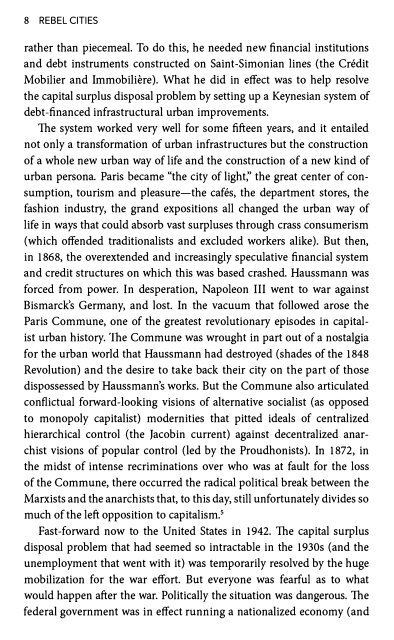Rebel Cities-David Harvey
Rebel Cities-David Harvey
Rebel Cities-David Harvey
- No tags were found...
Create successful ePaper yourself
Turn your PDF publications into a flip-book with our unique Google optimized e-Paper software.
8 REBEL CITIESrather than piecemeal. To do this, he needed new financial institutionsand debt instruments constructed on Saint-Simonian lines (the CreditMobilier and Immobiliere). What he did in effect was to help resolvethe capital surplus disposal problem by setting up a Keynesian system ofdebt-financed infrastructural urban improvements.The system worked very well for some fifteen years, and it entailednot only a transformation of urban infrastructures but the constructionof a whole new urban way of life and the construction of a new kind ofurban persona. Paris became "the city of light;' the great center of consumption,tourism and pleasure-the cafes, the department stores, thefashion industry, the grand expositions all changed the urban way oflife in ways that could absorb vast surpluses through crass consumerism(which offended traditionalists and excluded workers alike). But then,in 1868, the overextended and increasingly speculative financial systemand credit structures on which this was based crashed. Haussmann wasforced from power. In desperation, Napoleon III went to war againstBismarck's Germany, and lost. In the vacuum that followed arose theParis Commune, one of the greatest revolutionary episodes in capitalisturban history. 'lhe Commune was wrought in part out of a nostalgiafor the urban world that Haussmann had destroyed (shades of the 1848Revolution) and the desire to take back their city on the part of thosedispossessed by Haussmann's works. But the Commune also articulatedconflictual forward-looking visions of alternative socialist (as opposedto monopoly capitalist) modernities that pitted ideals of centralizedhierarchical control (the Jacobin current) against decentralized anarchistvisions of popular control (led by the Proudhonists). In 1872, inthe midst of intense recriminations over who was at fault for the lossof the Commune, there occurred the radical political break between theMarxists and the anarchists that, to this day, still unfortunately divides somuch of the left opposition to capitalism.5Fast-forward now to the United States in 1942. The capital surplusdisposal problem that had seemed so intractable in the 1930s (and theunemployment that went with it) was temporarily resolved by the hugemobilization for the war effort. But everyone was fearful as to whatwould happen after the war. Politically the situation was dangerous. Thefederal government was in effect running a nationalized economy (and


